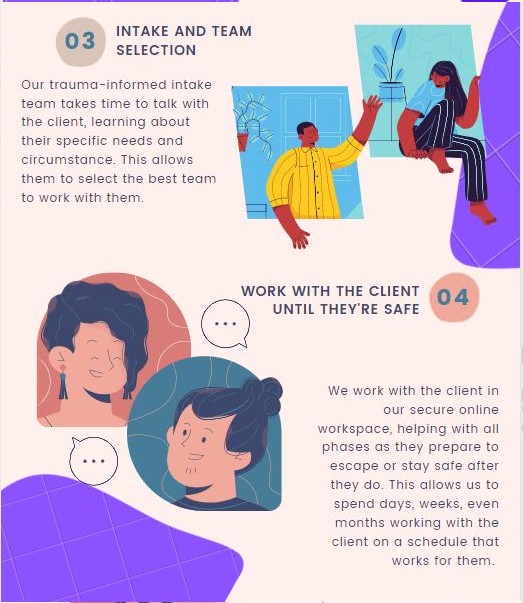
First of all, well. It works well.
We’ve developed this process over years, constantly improving and looking for new ways to protect those we serve. That’s why we’ve participated in thousands of successful escapes.
While every case is unique, this shows how Operation Safe Escape works in a general sense.


Pillars of Support
Educate
Education is power. We work with the client to help them protect themselves and their loved ones. We also work with their support system, partners, public safety, and legislatures to help them understand their role in combatting abuse.
Escape
Ultimately, the goal is to make sure that anyone impacted by domestic violence, stalking, harassment, and human trafficking makes it out safely and stays safe after they do. We help with escape planning, coordination, gaining privacy, and starting their new life.
Empower
Everyone deserves to be safe, and everyone deserves to feel safe. We always respect the client's agency and give them the tools they need to make their own secure choices down the road. This lets them take control of their home, devices, and their life.
Common Questions
No. We never charge clients for our services, because we believe they need to use their money elsewhere as they start their new life. Our only mission is to help others; by providing this as a free service, our clients can avoid costly IT service bills, physical security consulting costs, and more.
No, we don’t charge partners for our assistance. Much like our philosophy regarding clients, we believe that our partners can be more effective if they have more resources available to them.
In some cases, yes. But this is a rare occurrence and depends on several factors. In general, we’ve found that it’s safer for the client and the helpers to work asynchronously and in our secure online workspace.
This is largely because there is risk involved any time the client meets with someone in the physical world. Additionally, our engagements often last weeks at a time or more, so going at the client’s pace is less stressful for them.
More often, we’ll work with partners- such as social workers or public safety- on site when needed, included presentations and hands-on training.
No. Many volunteers prefer to work in other capacities, such as graphic design, research, content creation, and more.
The mental health and well-being of our volunteers are among our highest priorities, and no one is expected to sacrifice their health. In cases where the volunteer needs to step away, a new helper is introduced to the client to continue care.
